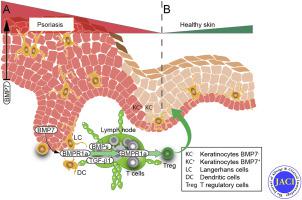Journal of Allergy and Clinical Immunology ( IF 11.4 ) Pub Date : 2020-10-22 , DOI: 10.1016/j.jaci.2020.09.038 Tommaso Sconocchia 1 , Mathias Hochgerner 2 , Elke Schwarzenberger 1 , Carmen Tam-Amersdorfer 1 , Izabela Borek 1 , Theresa Benezeder 3 , Thomas Bauer 2 , Victoria Zyulina 1 , Clemens Painsi 4 , Christina Passegger 1 , Peter Wolf 3 , Maria Sibilia 2 , Herbert Strobl 1

|
Background
Bone morphogenetic proteins (BMPs) are members of the TGF-β family that signal via the BMP receptor (BMPR) signaling cascade, distinct from canonical TGF-β signaling. BMP downstream signaling is strongly induced within epidermal keratinocytes in cutaneous psoriatic lesions, and BMP7 instructs monocytic cells to acquire characteristics of psoriasis-associated Langerhans dendritic cells (DCs). Regulatory T (Treg)-cell numbers strongly increase during psoriatic skin inflammation and were recently shown to limit psoriatic skin inflammation. However, the factors mediating Treg-cell accumulation in psoriatic skin currently remain unknown.
Objective
We sought to investigate the role of BMP signaling in Treg-cell accumulation in psoriasis.
Methods
The following methods were used: immunohistology of patients and healthy controls; ex vivo models of Treg-cell generation in the presence or absence of Langerhans cells; analysis of BMP versus canonical TGF-β signaling in DCs and Treg cells; and modeling of psoriatic skin inflammation in mice lacking the BMPR type 1a in CD11c+ cells.
Results
We here demonstrated a positive correlation between Treg-cell numbers and epidermal BMP7 expression in cutaneous psoriatic lesions and show that unlike Treg cells from healthy skin, a portion of inflammation-associated Treg cells exhibit constitutive-active BMP signaling. We further found that BMPR signaling licenses inflammation-associated Langerhans cell/DC to gain an enhanced capacity to promote Treg cells via BMPR-mediated CD25 induction and that this effect is associated with reduced skin inflammation.
Conclusions
Psoriatic lesions are marked by constitutive high BMP7/BMPR signaling in keratinocytes, which instructs inflammatory DCs to gain enhanced Treg-cell–stimulatory activity. Locally secreted BMP7 can directly promote Treg-cell generation through the BMP signaling cascade.
中文翻译:

骨形态发生蛋白信号通过调节树突细胞功能调节皮肤炎症
背景
骨形态发生蛋白 (BMP) 是 TGF-β 家族的成员,通过 BMP 受体 (BMPR) 信号级联传递信号,与经典的 TGF-β 信号传导不同。BMP 下游信号在皮肤银屑病病变的表皮角质形成细胞内被强烈诱导,BMP7 指示单核细胞获得银屑病相关朗格汉斯树突细胞 (DC) 的特征。调节性 T (Treg) 细胞数量在银屑病皮肤炎症期间强烈增加,最近被证明可以限制银屑病皮肤炎症。然而,目前尚不清楚银屑病皮肤中介导 Treg 细胞积累的因素。
客观的
我们试图研究 BMP 信号在银屑病中 Treg 细胞积累中的作用。
方法
使用以下方法:患者和健康对照的免疫组织学;在存在或不存在朗格汉斯细胞的情况下 Treg 细胞生成的离体模型;DCs 和 Treg 细胞中 BMP 与经典 TGF-β 信号的分析;CD11c +细胞中缺乏 BMPR 1a 型的小鼠的银屑病皮肤炎症模型。
结果
我们在这里证明了皮肤银屑病病变中 Treg 细胞数量和表皮 BMP7 表达之间的正相关性,并表明与来自健康皮肤的 Treg 细胞不同,一部分炎症相关的 Treg 细胞表现出组成型活性 BMP 信号。我们进一步发现,BMPR 信号允许炎症相关的朗格汉斯细胞/DC 获得增强的能力,通过 BMPR 介导的 CD25 诱导促进 Treg 细胞,并且这种作用与减少皮肤炎症有关。
结论
银屑病病变的特点是角质形成细胞中的组成型高 BMP7/BMPR 信号传导,这指示炎症 DC 获得增强的 Treg 细胞刺激活性。局部分泌的 BMP7 可以通过 BMP 信号级联直接促进 Treg 细胞的生成。











































 京公网安备 11010802027423号
京公网安备 11010802027423号